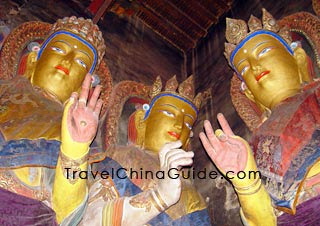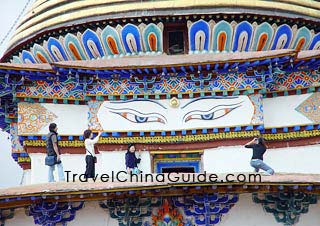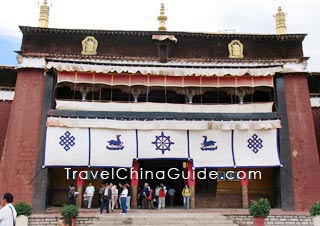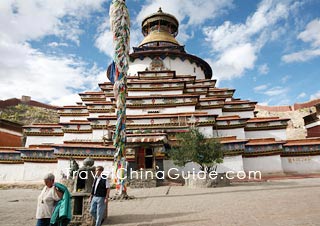Lying about 230 kilometers (143 miles) south of Lhasa and 100 kilometers (62 miles) east of Shigatse, Palcho Monastery (Pelkhor Choede or Palcho Monastery) is a monastery having the characteristics of Han, Tibetan and Nepali architecture.
Palcho Monastery enjoys a high status in Tibet Buddhism history because it houses three sects - Sakyapa, Kadampa and Gelugpa together. Those three sects get along well with each other though they once quarreled and fought. The Bodhi Dagoba, the Main Assembly Hall, murals and Zhacang (hall for the monks) in the monastery are the most renowned.
 | | Zhacang (hall for the monks) | |  | | Murals, Palcho Monastery | |
Bodhi Dagoba
The Bodhi Dagoba about 32 meters (105 feet) high is a nine-tier building which has 108 gates, and 76 chapels and shrines. It is the symbol of the Palcho Monastery. In Tibetan, the Bodhi Dagoba is called 'Kumbum'. It also has another name 'Ten Thousand Buddha Pagoda'. About ten thousand figures of Buddha are celebrated in the chapels, shrines or as murals in the pagoda, hence its name. The pagoda comprises nearly one hundred chapels which overlap one another. People call this kind of structure 'tower upon tower'.
Main Assembly Hall
The Main Assembly Hall of Palcho Monastery has a history of about five hundred years. In Tibetan, it is called 'Tshomchen'. It is a three-storied building. On the first floor are the Main Chapel, Eastern and Western Chapels, and the cloister. In the Main Chapel is the bronze statue of Sakyamuni with a height of nearly eight meters (26 feet). It is said that about 14,000 kilograms (30,865 pounds) of copper were used to build the statue. Built with 48 columns, the chapel is decorated with numerous silk '
Thangkas'. On the second floor, Manjusri Bodhisattva, White Tara and Arhats are enshrined in the chapels. The eighteen-Arhat clay sculptures in the Arhat chapel are renowned in Tibet. On the third floor, Amitabha Buddha, Dakinis and esoteric Buddhism murals are displayed in the chapels.
 | | Main Assembly Hall | |  | | Bodhi Dagoba | |
Murals
Murals in the Palcho Monastery are also well known. These murals mainly relate to Esoteric and Exoteric Buddhism, and stories about the Buddhas. Tourists will find them almost everywhere in the monastery. Zhacang refers to the rooms where the monks live. Each sect has their own Zhacang in the monastery.
Saka Dawa Festival
According to Tibetan calendar, April 15th is the most important day of the year. Saka Dawa Festival will be held on that day to commemorate Sakyamuni, the founder of
Buddhism. It is said that Sakyamuni was born and passed away on April 15th. During the festival, about five hundred Lamas chant sutras and the loyal pilgrims gather in Palcho Monastery to commemorate Sakyamuni together.
Tips
1. Tourists need to pay CNY 10 if they want to bring their camera into the Bodhi Dagoba.
2. To get to Palcho Monastery, tourists should take the minibus (Shigatse-Gyangtse) at Shigatse Bus Station. The ticket is about CNY 25 per person. Arriving at Gyangtse, take a short walk to Palcho Monastery.
How to get to Palcho Monastery from Lhasa
1. Take a bus from Xijiao Bus Station to Gyangtse and then take a taxi to the temple.
2. Take a bus from Xijiao Bus Station to Shigatse and then transfer to a bus to Gyangtse; after arrival, take a taxi to Palcho Monastery.
- Last updated on Jul. 18, 2022 -



